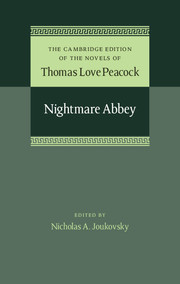Book contents
- Frontmatter
- Contents
- List of Illustrations
- General Editor’s Preface
- Acknowledgements
- Chronology
- List of Abbreviations
- Introduction
- Nightmare Abbey
- Appendix A Peacock’s Preface of 1837
- Appendix B An Essay on Fashionable Literature (1818)
- Appendix C The Four Ages of Poetry (1820)
- Note on the Text
- Emendations and Variants
- Ambiguous Line-End Hyphenations
- Explanatory Notes
- Select Bibliography
Introduction
Published online by Cambridge University Press: 30 June 2022
- Frontmatter
- Contents
- List of Illustrations
- General Editor’s Preface
- Acknowledgements
- Chronology
- List of Abbreviations
- Introduction
- Nightmare Abbey
- Appendix A Peacock’s Preface of 1837
- Appendix B An Essay on Fashionable Literature (1818)
- Appendix C The Four Ages of Poetry (1820)
- Note on the Text
- Emendations and Variants
- Ambiguous Line-End Hyphenations
- Explanatory Notes
- Select Bibliography
Summary
GENESIS AND COMPOSITION
In his Preface to the Standard Novels edition of 1837 Peacock asserted that Nightmare Abbey was written in 1817, but if this was not a misprint, his usually reliable memory must have failed him. All other evidence, including his extant correspondence with Shelley and T. J. Hogg, indicates that his third novel was conceived and written, as well as published, in 1818. His brief comments clearly suggest that his satire on ‘the gloom and misanthropy of modern literature’ was undertaken, at least in part, as a cure for his own despondency in the weeks following Shelley's departure for Italy. His ‘comic romance’ was, in effect, an antidote to his earlier poem The Philosophy of Melancholy (1812).
In March 1817 Shelley moved into his house at Marlow, which he had taken partly for the sake of being near Peacock, and ‘settled himself down, as he supposed, for life’. ‘This was’, Peacock recalled in his Memoirs, ‘an agreeable year to all of us’. Melincourt was published early in March, and it was probably in the spring or summer of 1817 that Peacock wrote the longest of his unfinished tales, known as ‘Calidore’, as well as his second book of verse for children, The Round Table; or, King Arthur's Feast. Some time between 2 October and 11 November, Hogg remarked in a much-revised draft of a letter to Shelley: ‘Peacock I trust is climbing upon some steps in his Poem & a new Novel nearer to honour & profit.’ The poem was Rhododaphne; or, The Thessalian Spell, which Shelley described, in a letter to Hogg of 28 November, as ‘a story of classical mystery and magic—the transfused essence of Lucian, Petronius, and Apuleius’. The new novel, on the other hand, was evidently a matter of conjecture. Rhododaphne was copied by Mary Shelley on 4–10 December and published by Thomas Hookham early in February; but Peacock did not begin work on Nightmare Abbey until the spring.
The earliest known references to Nightmare Abbey all date from after Shelley's departure for Italy on 11 March 1818. Peacock had spent the previous month in London, sharing in many of the activities that occupied Shelley's last days in England.
- Type
- Chapter
- Information
- Nightmare Abbey , pp. lxiii - cxliiPublisher: Cambridge University PressPrint publication year: 2016



